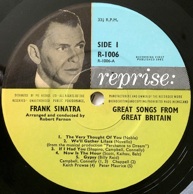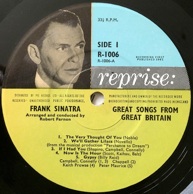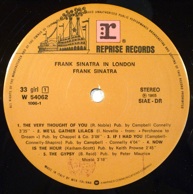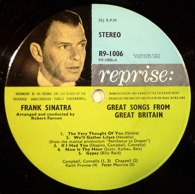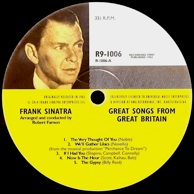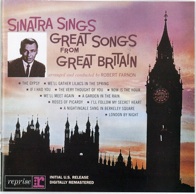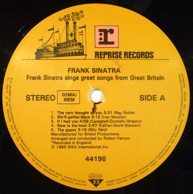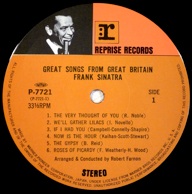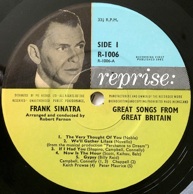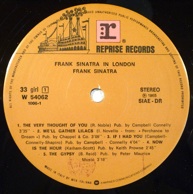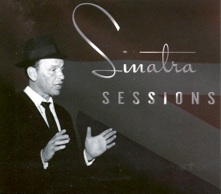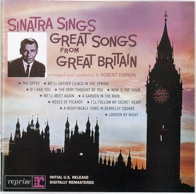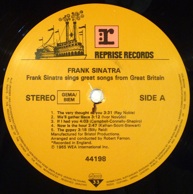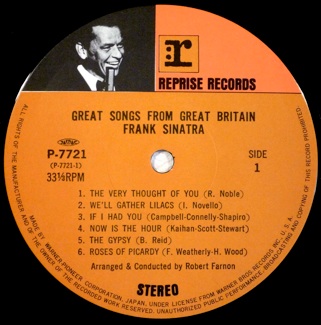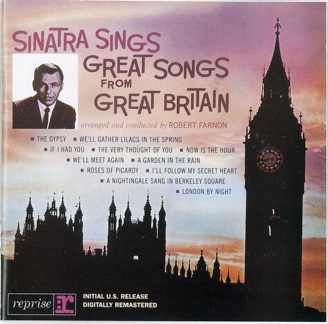Sinatra Sings Great Songs from GREAT BRITAIN - 1962

How to start dissecting this album and its recording history? First, there’s the obvious: It’s Sinatra’s only studio album made outside of the United States. It’s Sinatra’s only album arranged by Robert Farnon, who proves himself to be quite up to the task, creating another of those interesting, one-off albums that dot the Reprise landscape. The album was released originally in the UK only, finally being released in other European countries and Japan on LP through the 1970s and 1980s, reaching the US via CD only in 1993, 31 years late, after missing an only-slightly-tardy, apparently-planned-but-ultimately-scrapped US release date of 1965. In the 1980s, in Japan only (but released elsewhere about eight years later), a very intriguing, haunting bonus track from the sessions appeared.
....and that’s just the tip of the iceberg.
Pye Records executive Alan Freeman acted as producer. The technical recording duties were helmed by well-known “Star Wars” engineer Eric Tomlinson, 15-years prior to receiving that assignment, and he did a beautiful job on the album, achieving an excellent orchestral balance, and very good overall tone, a mark often missed on Reprise releases to this point. Adding to the oddities surrounding this album, it has appeared in different countries in different mixes and different edits, often with sub-par mastering, and from tape sources that appear to be compromised.

In which Frank sinatra, Bill Miller, Nelson Riddle, Jack Daniels, and a very talented canadian arranger assemble in London for sessions full of British-penned music-making.
Recorded at Cine-Tele Sound (CTS) Studios, Bayswater, London, June 12-14, 1962
Released: October, 1962, UK
Producer: Alan Freeman Arranged and Conducted by Robert Farnon
Engineer: Eric Tomlinson



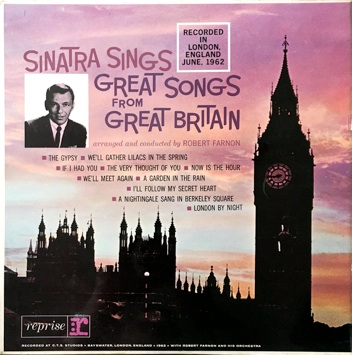
The orchestra was laid out according to the diagram at left, essentially divided into four quadrants for the orchestra, plus rhythm section. Two quadrants were assigned to the left track, two to the right track, and the rhythm was somewhat “divvied up” between the three tape channels, although I think that Sinatra was all by himself on the center track. The other instruments that are marked as “center” may be, as SHTV’s Lukpac suggested as a possibility, assigned to both tracks 1 and 3 (left and right), making them sound centered in the stereo mix, but still allowing Sinatra’s vocal levels to be balanced independently. This sort of track assignment, combined with some microphone leakage (not surprising, considering the proximity and assorted panning of rhythm-section instruments, denoted at left), would also explain why the “center” instruments wander a bit at times.
Microphones pictured in session photos appear to include:
•Neumann M49 - Sinatra’s vocal; guitar
•Neumann U67 - Upright bass
•Neumann KM56 - reeds; possibly also on percussion
•Neumann KM54 - strings
•Neumann U47 - Celeste
Based on information available online, the album was likely recorded (uniquely in the Sinatra catalog) on a Philips 3-track machine, via Agfa tape and a 12-input Telefunken mixing console. (The liner notes to the recent “London” boxed set suggest that a Neve console was used, but that appears to be based on inaccurate memories, as Neve was a start-up company in 1961, and other CTS references are to a Telefunken console.)
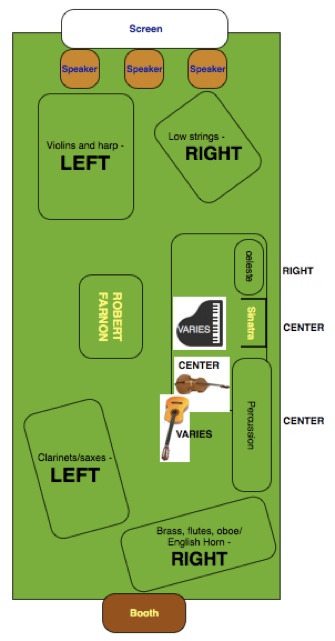
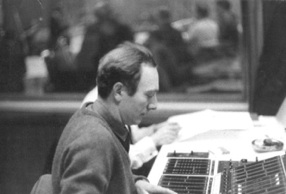
“Eric Tomlinson at the mixing console at CTS Studios in Bayswater during the early 1960s”
--from this published interview
it was the best of tapes, it was the worst of tapes

In a nutshell, the “sound quality analysis” of this album comes down to a Tale of Two Tapes: Good source tapes, and bad source tapes. Between 1962 and 1976, a handful of international (non-USA) releases were made from good, or “clean” source tapes, tapes that were largely free of defects. Those “good tape” releases include:
•1962 UK Mono LPs
•1962 UK Stereo LPs
•1976 Italy Stereo LP, retitled “Sinatra in London”
...and possibly others, including, perhaps, the 1960s Australia, France, Japan (#SJET-7403) and Netherlands LPs, and an early ‘70s UK stereo release, which were not sampled here.
For other releases, new mixes were used, mixes that were sourced from defective 3-track master tapes. These “bad tape” releases include:
•1980s Germany stereo LP (4 songs with alternate edits)
•1980s Japan stereo LP (4 songs with alternate edits, with “Roses of Picardy” added in mono)
•1993 CD (tracks reused in the “suitcase” set, 3 songs with alternate edits, “Roses of Picardy” in stereo)
•2014/2015 LP/CD/HD (3 songs with alternate edits; “Roses of Picardy” in stereo [CD/HD only])

Audio Clips: “london by night”
in these comparisons, the difference between “good tapes” and “compromised tapes” is striking.
The above information is KEY to figuring why some releases of this album sound so “wrong,” but it’s purely the Cliff’s Notes version of the novel.
As much as I love minutiae and “detail” stuff, even I started to doze off reading all the little details. Minutiae? There is copious minutiae where the “sound problems” of this album are concerned; so much that I did not want to clutter this page with all the details, so for anybody who WANTS to get into the nitty gritty of what the problems are, I direct you to a separate page that covers that very material. Please see this link, and you can root around in the weeds to your heart’s content.
Audio Clips: “We’ll Gather Lilacs in the Spring”
In the good tape vs. “compromised” tape construct, “We’ll Gather Lilacs” is relatively problem free across all releases, a sort of “best case scenario” for comparison.
All clips posted here correspond with the 90-second clips freely available via iTunes. Click “view” below to access 90-second clips.
The following releases are all cut from “clean tapes.” (See notes above.)
CLICK PHOTOS TO HEAR AUDIO.
Above: Original UK mono LP, courtesy SH.TV’s BFerr1
Above: Original UK -4M mono LP, courtesy SH.TV’s Pieter Kozak
Above: Original UK -3L stereo LP (worn copy) - STEREO MIX #1, but mastered very “right heavy”
Above: 1976 Italy “Sinatra in London” LP -
STEREO MIX #1, but with proper left/right balance
The following releases (below) are all remixed from problematic 3-track tapes. (See notes above.) Reminder: On this particular song, the tape-source problems are relatively mild.
CLICK PHOTOS TO HEAR AUDIO.
Above: c. 1985 Germany stereo LP - STEREO MIX #2
Above: c. 1985 Japan stereo LP - STEREO MIX #2
Above: 1993 stereo CD - STEREO MIX #3 (reused in the 1995 “suitcase” set.)
Above: 2015 digitally-mastered stereo LP - STEREO MIX #4, courtesy BFerr1 (same 2014 digital remix)
Above: 2014 stereo CD (from LONDON box set) - STEREO MIX #4 (16-bit version of the then-forthcoming HD release)
Clearly, the German and Japanese LPs are cut from the same cloth.
All clips posted here correspond with the 90-second clips freely available via iTunes. Click “view” below to access 90-second clips.
The following releases are all cut from “clean tapes.” (See notes above.)
CLICK PHOTOS TO HEAR AUDIO.
Above: Original UK -2WMH mono LP, courtesy SH.TV’s Pieter Kozak
Above: 1976 Italy “Sinatra in London” LP -
STEREO MIX #1
Above: 2014 “Sessions” bonus CD from the LONDON boxed set - STEREO MIX #1?
The following releases (below) are all remixed from problematic 3-track tapes. (See notes above.)
FOCUS ON THE SOUND OF THE VOICE on these recordings.
CLICK PHOTOS TO HEAR AUDIO.
Above: c. 1985 Germany stereo LP - STEREO MIX #2
Above: 1993 stereo CD - STEREO MIX #3 (reused in the 1995 “suitcase” set), courtesy SH.TV’s Bob F.
Above: 2014 stereo “Great Songs from Great Britain” CD (from LONDON box set) - STEREO MIX #4 (16-bit version of the then-forthcoming HD release). The 2015 LP was cut from the same digital master, with essentially-identical sound.

Thanks for listening, and don’t forget to check out the list of technical details on page two, if you are so inclined.
Sincerely,
Matthew Lutthans
April 24, 2017
Bottom Line
The German and Japanese stereo LPs from the 1980s use a poor-sounding remix from problematic tapes that includes four alternate edits, and, try as I might, I really can’t say anything nice about the tracks on these releases.
The 2014/2015 releases are largely sourced from the same problem-laden tapes, compounded by some very distracting digital cleanup, with three songs that have alternate edits. They are a definite step up from the Japanese/German LPs, but that’s about it. Sub-par.
The 1993 CD (re-used in the “suitcase” set in 1995) is another step up on some tracks, notably IF I HAD YOU, THE GYPSY, and WE’LL MEET AGAIN, which sound very good, and may be the best sounding versions. Sadly, the other tracks are saddled by many of the same tape-source technical problems that plague the releases mentioned in the previous paragraph.
The 1962 UK Mono LP and 1976 Italian Stereo LP have consistently good sound quality, using original mixes and edits, sourced from correct, clean, non-defective tapes. Both are very nice, but I strongly prefer the 1976 Italian LP, as the stereo orchestral recording here is really top notch.
TECHNICAL NOTE: You may notice that I have made no mention of the UK stereo LP. My personal copy, a -3L/-3L cut, is more than 3dB louder on the right channel than on the left, and the tone is adequately good, but not as nice as the Italian LP. Tone aside, I cannot recommend an LP with such a left/right imbalance as any sort of “top choice” when there are properly balanced, better sounding options available. That said, I suspect that there may be other UK copies that are not so “right heavy” as mine is, and that may exhibit better tone. Such a pressing would certainly earn my recommendation, if it exists.
To my ears, in a sea of “dud” releases of this album that are chock full of technical problems and bad sound, there is literally one version that sits alone at the top, and it’s this one. My advice? Go to Discogs or Ebay and buy one. They seem to be plentiful. Original UK mono also very good.
The 1962 UK mono LPs are pretty good, too, but that Italian stereo LP, while not without flaws, is the top choice, in my opinion.
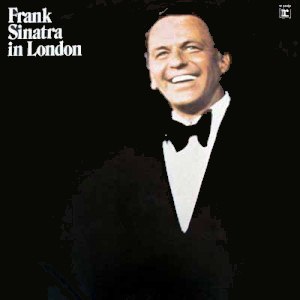





Bonus Track: “Roses of Picardy”
This track has only ever had three masterings, to my knowledge: 1.) The 1985 Japanese “Great Songs from Great Britain” LP; 2.) The 1993 CD (reused in the Complete Reprise Recordings set two years later); and 3.) the 2014 LONDON boxed set, with the same mix in HD a year later. Below are audio clips, with commentary. PLEASE CLICK ON THE PHOTO FOR AUDIO SAMPLES.
Above: 1985 Japan LP, with this song in mono, despite the other 10 tracks being in remixed stereo.
This is the initial official release for this song, and it appears in a mono mix that has reverb, tone, and compression characteristics that mirror the stereo mixes of the 10 standard album tracks on the same disk. I would not rule out the possibility that this track was remixed concurrently with the other 10 tracks, but then intentionally folded down to mono. It seems possible to me that Yasuo Sangu or somebody else connected to the Sinatra Society of Japan had a dislike for the type of stereo sound they were getting on Sinatra LPs of the early ‘60s, and when the chance came for the Society to be directly involved with issuing additional, previously unreleased tracks, this bonus material was intentionally and oddly “narrowed” in terms of stereo presentation. A similar situation arose with the two first-release bonus tracks on SINATRA & STRINGS.
Above: 1993 remix by Lee Herschberg.
There’s a prominent splash of plate reverb added, which adds a bit of a splatter-y effect to the vocal, but Frank’s voice remains pleasantly “out front,” and tone is good, even if a tad bright and tinsel-y or splatter-y.
Above: 2014 LONDON boxed set.
Tone is excellent, and there’s plenty to like here. On the whole, though, the vocal fights with the orchestra, rather than being supported and surrounded by it. In several spots, I want to hear more Sinatra. This may be part of the live-to-stereo 2-track tape, rather than a remix from the 3-track, but with no original-release reference for comparison, it is hard to say for certain. I’m fairly confident that this is a new remix.
None of the choices is “spot on,” but, for “Roses of Picardy,” I prefer the 1993 remix to either of the others, despite its technical characteristics.
